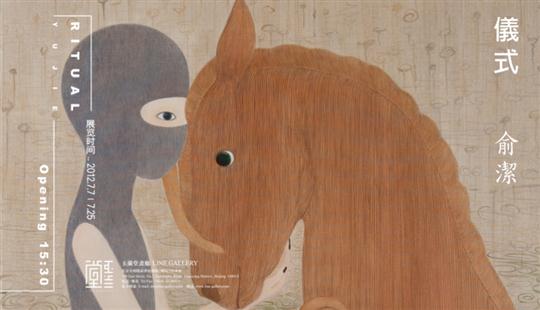Ritual
works of Yu Jie
2012.07.07 - 25
|

Fable:
To use cartoon or conceptual methods to understand Yu Jie’s painting might be ineffective. Her current and earlier paintings both have a narrative quality: the constrained expression of feelings and the hidden conflicts, which allow her painting to dwell in the incomplete moment between poetic sentiment and drama. Thus, each of her painting carries a looming event.
In her paintings there is no personality, not even gender. The animals have “humanness”, with a secret sense of equality, exchange, and blending among each other. Therefore the antler, rabbit head, animal skin, air, tress, star-lit sky, and surprised eyes all become heuristic symbols. It is through these symbols Yu Jie translates her day-to-day experience into a personal fable. Those who are familiar with the contemporary arts, based on their own experiences, might treat it as a cartoon-like joy, but her meditative quality reveals to the more observant viewers the Eastern wisdom and consciousness.
Faces:
For a lot of artists, faces express personal or social anger, such as confusion, imprisonment, and madness. Not long ago this way of expression was still valid, yet suddenly, the image that was previously politically and socially meaningful atomized. Its typicality becomes intangible.
In the works of Yu Jie, a masked face, the mouth and ears that she (or he) uses to speak and listen are covered, leaving only a pair of eyes. In a rapidly changing country, all judgments of right or wrong and judgments based on experience become embarrassment. Contemporary life is like a hologram, which, you only have the right to observe but not the power to judge.
For these images, what were covered were not merely the faces, but the sociality of the faces. Yu Jie makes the human face cleaner and no longer so important. Her art becomes a rebuttal of the ideology of facial expression.
Here the mask becomes a curtain, behind which are infinite curiosity and an alternative existence. The mask is also a taboo, boundary, and a certain kind of asylum.
Jorge Luis Borges said, regarding to religion: “An image has been lost, and it can not be seen again.” In a contemporary time where “disguise” and “stealth” prevails, the human face has become gradually obscure. After all, all faces remembered are the light beyond the faces, rather than the faces themselves.
Ritual:
In her recent paintings, Yu Jie gave up the graffiti like impromptu style of previous years, and adapted more “writing” elements. As an artist who emphasizes oriental characteristics, she uses a moderated form to hide reality behind images.
She made a lot of paintings that are seemingly too clean. The characters are self-sufficiency. These people and objects are immersed in their own focus without looking at the viewers –they’ve not discovered that they are “being watched.” So what are they doing? To give a few examples: someone is washing a horse – but a wood horse; someone is praying in a particle – but an exploding particle; and someone looks upon a rabbit head – with a sense of sacrifice offered. When we observe carefully, we discover what they are doing is not daily routines, but more of a certain stance and performance.
Like in a ritual or ceremony, the energy field created on the canvas also allows a daily object to rise above its usual properties, to a metaphysical level In the same sense, as an artist accustomed to silence, through her paintbrush she flies slightly above the ground, above the noisy reality, and achieves “holiness” in her heart. To a certain extent, what to paint is not that important; what is important is that the stance is clear; what is important is the image behind the canvas.
|
|

